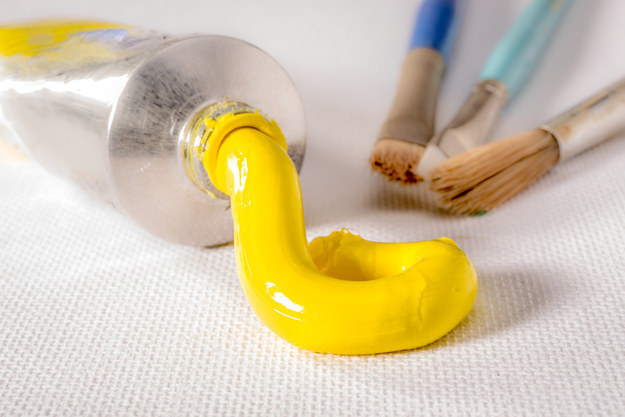Life is hard.
Alice Mongkongllite / BuzzFeed
You broke your penis.
Okay, so there isn’t a bone in your penis, but you can fracture it. This happens when there’s a tear in the part of the penis called the tunica albuginea. When it happens (typically during sex), you’ll notice a loud popping sound and an immediate loss of your erection. Get to the emergency room ASAP, because studies show that the outcomes are better if you’re seen within the first 24 hours. Here’s more info on .
Your boner won’t cooperate after a few drinks.

Artlite / Getty Images / Via thinkstockphotos.com
Too much alcohol can make it harder for you to get an erection, keep an erection, or ejaculate, Dr. Harry Fisch, clinical professor of urology and reproductive medicine at Weill Cornell Medical College, tells BuzzFeed Life. It’s most likely because alcohol acts as a depressant that dulls your senses (including your penile senses). So if you plan on using your penis later, set an alcohol limit early on in the night.
You notice blood in your semen.

Okay, try not to freak out. This is called hematospermia or hemospermia and it’s usually not cancer, says Fisch. This could be a one-time thing or a persistent problem, and while it usually goes away on its own, you probably want to check with a doctor if it continues.
“Blood in the semen almost always has a benign cause,” Dr. Abraham Morgentaler, director of Men’s Health Boston and associate clinical professor of urology at Harvard Medical School, tells BuzzFeed Life. It could be from inflammation or infection in the prostate or seminal vesicles, stones in the ejaculatory ducts, or a whole list of other things. Sometimes doctors can’t figure out the precise cause, but it’s often nothing major, says Morgentaler. That said, if you’re seeing blood in your urine, definitely get that checked out since it might be something more serious.
You have blue balls.
Not technically a penis problem, but it’s in the same general vicinity and your member is involved. — though they don’t actually turn blue. This refers to the testicular pain that occurs after prolonged sexual stimulation without ejaculation. Basically what happens is that all that blood flow and fluid build-up can make your balls hurt A LOT. Luckily, it goes away with ejaculation or just time. And obviously this is no reason to whine to your partner to finish you off — your own hand can get the job done just fine.
You keep going and going and going and can’t ejaculate.

Comedy Central / Via madeupmonkeyshit.tumblr.com
Delayed ejaculation is when you have no issue getting or keeping an erection, but you have a problem ejaculating — particularly with a partner. This often happens as a result of too much masturbation or masturbating in a way that’s not really replicable with a partner (like with a serious grip or lightning speed or only when you’re watching a certain type of porn), says Fisch. Certain medications like high blood pressure pills, antidepressants, and narcotics may also play a role. If this is happening to you, first see if you can cut back on your masturbation habits or change the way you typically get off by yourself. If that doesn’t help, talk to a doctor about any possible physical or psychological factors that might be behind it. Here are a few more .
You orgasm really really quickly and you’re upset about it.

Premature ejaculation (PE) is typically defined as having an orgasm within one minute of penetration and feeling distressed or anxious because of it, says Morgentaler. There are two kinds of PE: lifelong (when it’s pretty much always been the case) or acquired (when it’s new). The important thing to note here is that there’s nothing biologically wrong with people with PE, says Morgentaler, and experts aren’t entirely sure what causes it. With acquired PE, there’s often a psychological element to it (and the more it happens, the more anxious you get, and the more anxious you get, the more it happens, etc.).
Treatment typically includes counseling, medications that can slow down the ejaculation process, or desensitizing sprays or wipes (Fisch actually developed one product called Preboost, which contains an FDA-approved ingredient for treating PE). Important: This might not bother you or your partner at all, so if that’s the case, don’t worry about it!
Your penis is really bent and it hurts.

Ntdanai / Getty Images / Via thinkstockphotos.com
Peyronie’s disease is the kind of curved penis that’s actually a problem — not to be confused with a bent penis that’s always been like that. “Very few men are perfectly straight like a steel rod,” says Morgentaler. “Some degree of curvature — even a banana curve — is normal, especially if they’ve always been that way.”
Peyronie’s disease is when you develop a new curvature of the penis that’s associated with painful erections. It’s caused by scarring on the inside of the penis, which is often the result of some sort of trauma or injury that didn’t heal properly (see: penis fracture above). Penis trauma sounds like something you would remember, but actually only about 20% of people with this condition can pinpoint the cause, says Morgentaler. So even if you don’t remember hitting your penis on anything, if you have a new bend in your member and painful erections, see a doctor right away.
You’ve got jock itch.


This is actually called tinia cruris, and it’s a fungal infection on your groin or genitals. You might notice some itchiness or redness in the creases by your thighs and butt, and in unfortunate cases, it can extend to your scrotum or genitals. It’s caused by heat, sweat, and skin rubbing together, so wearing breathable fabrics and loose-fitting clothing can help. And if you sweat a lot (especially in the ball region), Morgentaler suggests using a talcum powder to prevent jock itch. Make sure to also to prevent it. If you’ve already got it, there are OTC anti-fungal creams that can help, or you can go to your doctor for a prescription-strength one.
Your penis is red and there’s maybe some itching and burning.

Ugreen / Getty Images / Via thinkstockphotos.com
This might be a yeast infection. Yep, men can get these, too. It can happen if you’re overweight, if you’re diabetic, if you’re taking antibiotics, or if you contract it through unprotected sex with someone who has a yeast infection, says Fisch. It’s also more common in uncircumcised penises, simply because yeast thrives in dark, moist areas like underneath the foreskin. So if you have a reddish rash or any itching or burning, check it out with your doctor. They’ll often prescribe an OTC anti-fungal treatment.
No, seriously, there’s A LOT of inflammation on your penis.

Ye Liew / Getty Images / Via thinkstockphotos.com
This could also be balanitis, an umbrella term for any inflammation of the penis, says Fisch. It can be caused by yeast infections and other STIs, but it can also be caused by poor hygiene, skin irritation, or smegma (a foul-smelling substance that can build up under the foreskin). Basically, balanitis is when your penis is inflamed for whatever reason. Head to your doctor if this happens; they can pinpoint the cause and help you treat it.
Something is coming out of your penis and it’s not cum or pee.

Jfjacobsz / Getty Images / Via thinkstockphotos.com
If you’re having a discharge from your urethra that’s not ejaculate, see your doctor. This could be a sign of gonorrhea or chlamydia, which are sexually transmitted infections (STIs) that are treatable. Find out more about here.
You have warts on or near your penis.

Ninell_art / Getty Images / Via thinkstockphotos.com
This could be genital warts, also referred to as condyloma. These are the bumps associated with some types of the human papilloma virus (HPV), a very common STI. They can be found on the genitals, mouth, rectum or anus (basically anywhere sexual contact occurred with someone who had the virus).
You got a penis piercing, and there are some… complications.

Michaklootwijk / Getty Images / Via thinkstockphotos.com
So you decided to get a Prince Albert piercing (that’s a piercing on the head of your penis, FYI). Keep in mind that there’s one pretty common complication that can come from it. Since it goes through the urethra, there’s a chance that the piercing can create a urethral fistula, and you might end up urinating out of that hole, says Morgentaler. You can get surgery to repair it.
You can’t get a boner.

Saiyood / Getty Images / Via thinkstockphotos.com
Important: Erectile dysfunction (ED) can happen at any age, so don’t assume you’re too young to have this issue. The most common cause is actually psychological, says Morgentaler, which doesn’t mean it’s all in your head — it just means that anxiety and nerves (two very strong factors) are messing with your boner. “If men can have a good erection at any other time, then usually the plumbing is just fine and it’s something about the situation that isn’t letting the normal blood flow changes happen,” he says.
But there are also some physical causes of ED, which are primarily vascular. It could be that not enough blood flow is getting to the penis or that blood flow is leaving before it should, says Morgentaler. It could also be neurological (related to your nerve endings) or hormonal (related to your levels of testosterone). If you’re dealing with ED and you want a fix, talk to your doctor or therapist to help pinpoint the cause.
You have sores on or near your penis.

Mark Jessup / Getty Images / Via thinkstockphotos.com
This could be a sign of an STI, so you want to check it out with your doctor. It might be syphilis, which can cause painless sores or ulcers called chancres. These can look like little craters with raised edges, says Morgentaler.
Or it could be genital herpes if the sores look like little water blisters. “After a day or a couple days, the blisters disappear and leave behind a group of shallow ulcers or little pits that are often associated with pain or itching,” says Morgentaler. Herpes is an incurable but treatable STI that affects about 1 in 6 adults in the U.S.
Find out more about .
You have other lumps or bumps down there and you’re not sure what they are.

Allg / Getty Images / Via thinkstockphotos.com
Sometimes a little bump is just a little bump, says Morgentaler. “Many men have little bumps on the skin, some of which are like little hair follicles where no hair is actually there. Some are actually tiny sebaceous cysts,” which are benign bumps under the skin. If it worries you, check with your doctor anyway (especially if you’ve had unprotected sex), but it might just be nothing.
You can’t retract your foreskin, or you did retract it and now you can’t put it back.

Sruce2638 / Getty Images
Phimosis is when the foreskin is too tight (in adult uncircumcised males) and you can’t pull it back from the head of the penis. This might be caused by an infection, inflammation, or scarring of the penis. Head to your doctor to get it checked out and treated, which may include a topical cream or circumcision.
Paraphimosis is when the foreskin was already retracted and now won’t go back to it’s normal position over the head of the penis. This is considered a surgical emergency since it can cut off blood flow to the penis, says Fisch.
You have an erection that will not go away and it hurts.

DreamWorks SKG / Via aaronsmokesweedandwatchesmovies.tumblr.com
If you have a painful erection that won’t go away or persists even after you’ve ejaculated, this is called priapism. This might happen if you’ve taken an erectile dysfunction drug like Viagra. It can also happen if you have sickle cell anemia, if you’re on certain medications, if you’ve injected your penis with something for longer erections, or if you’ve had some sort of trauma to your penis, says Fisch. It’s basically a problem with the blood flow in and out of the penis, and you should seek medical attention ASAP. The treatment may include injecting medication, draining the blood from the penis, or possibly surgery.
You notice a growth or other visible changes on your penis.

Leeavison / Getty Images / Via thinkstockphotos.com
This could be a lot of different things (and it could be nothing), but it may also be penis cancer. Just remember: Penile cancer is very rare in North America and Europe, but it can happen. It occurs in less than 1 man in 100,000 in the U.S., according to the American Cancer Society. Most often, the symptoms are visible changes on the penis — like a thickened part of the penis, hard lumps or growths, or other new skin abnormalities. So if you notice of these signs or symptoms, tell your doctor.
There are a few risk factors associated with penile cancer, including smoking, chronic infection with some types of HPV, phimosis (which we talked about before), AIDs, and being over 55. It’s also more common in uncircumcised men, though that may be related to the other risk factors. According to the American Cancer Society, the risk of penile cancer is lower for men who were circumcised as children, but not lower for men who were circumcised as an adult. It’s important to note that the decision to circumcise is a personal one, and there are risks associated with this surgery as well.
Bottom line: If you notice something weird on/near/in your penis, get it checked out!
Don’t be embarrassed and don’t assume the worst. It’s probably nothing, but it could also be something with a quick and easy fix. If it is something more serious, it’ll be great that you sought medical attention early on. We know you probably love your penis (who wouldn’t?), so take good care of it — and take it to the doctor whenever the situation warrants it.


















